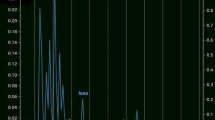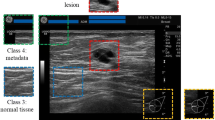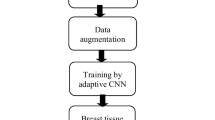Abstract
This study aimed to construct a breast ultrasound computer-aided prediction model based on the convolutional neural network (CNN) and investigate its diagnostic efficiency in breast cancer. A retrospective analysis was carried out, including 5000 breast ultrasound images (benign: 2500; malignant: 2500) as the training group. Different prediction models were constructed using CNN (based on InceptionV3, VGG16, ResNet50, and VGG19). Additionally, the constructed prediction models were tested using 1007 images of the test group (benign: 788; malignant: 219). The receiver operating characteristic curves were drawn, and the corresponding areas under the curve (AUCs) were obtained. The model with the highest AUC was selected, and its diagnostic accuracy was compared with that obtained by sonographers who performed and interpreted ultrasonographic examinations using 683 images of the comparison group (benign: 493; malignant: 190). In the model test with the test group images, the AUCs of the constructed InceptionV3, VGG16, ResNet50, and VGG19 models were 0.905, 0.866, 0.851, and 0.847, respectively. The InceptionV3 model showed the largest AUC, with statistically significant differences compared with the other models (P < 0.05). In the classification of the comparison group images, the AUC (0.913) of the InceptionV3 model was larger than that (0.846) obtained by sonographers, showing a statistically significant difference (P < 0.05). The breast ultrasound computer-aided prediction model based on CNN showed high accuracy in the prediction of breast cancer.




Similar content being viewed by others
References
Bray F, Ferlay J, Soerjomataram I, Siegel RL, Torre LA, Jemal A: Global cancer statistics 2018: GLOBOCAN estimates of incidence and mortality worldwide for 36 cancers in 185 countries. CA Cancer J Clin 68: 394–424,2018
Sadoughi F, Kazemy Z, Hamedan F, Owji L, Rahmanikatigari M, Azadboni TT: Artificial intelligence methods for the diagnosis of breast cancer by image processing: a review. Breast Cancer (Dove Med Press) 10: 219–230,2018
Abdel-Zaher AM, Eldeib AM: Breast cancer classification using deep belief networks. Expert Systems with Applications 46:139–144,2016
Seung Yeon S, Soochahn L, Il Dong Y, Sun Mi K, Kyoung Mu L: Joint weakly and semi-supervised deep learning for localization and classification of masses in breast ultrasound images. IEEE Trans Med Imaging 38:762–774,2019
Fujioka T, Kubota K, Mori M, Kikuchi Y, Katsuta L, Kasahara M, et al.: Distinction between benign and malignant breast masses at breast ultrasound using deep learning method with convolutional neural network. Jpn J Radiol 37:466–472,2019
Pehrson LM, Lauridsen C, Nielsen MB: Machine learning and deep learning applied in ultrasound. Ultraschall Med 39:379–381,2018
Byra M, Galperin M, Ojeda-Fournier H, Olson L, O'Boyle M, Comstock C, et al.: Breast mass classification in sonography with transfer learning using a deep convolutional neural network and color conversion. Med Phys 46:746–755,2019
Mendelson E, Böhm-Vélez M, Berg W: ACR BI-RADS® Ultrasound. In: ACR BI-RADS® Atlas, Breast Imaging Reporting and Data System. Reston: American College of Radiology, 2013
He J, Baxter SL, Xu J, Xu J, Zhou X, Zhang K: The practical implementation of artificial intelligence technologies in medicine. Nat Med 25:30–36,2019
Xiao T, Liu L, Li K, Qin W, Yu S, Li Z: Comparison of transferred deep neural networks in ultrasonic breast masses discrimination. Biomed Res Int 2018:4605191,2018
Becker AS, Mueller M, Stoffel E, Marcon M, Ghafoor S, Boss A: Classification of breast cancer in ultrasound imaging using a generic deep learning analysis software: a pilot study. Br J Radiol 91:20170576,2018
Han S, Kang HK, Jeong JY, Park MH, Kim W, Bang WC, et al.: A deep learning framework for supporting the classification of breast lesions in ultrasound images. Phys Med Biol 62:7714–7728,2017
Acknowledgments
We gratefully acknowledge the kind cooperation of Haihong Intellimage Medical Technology (Tianjin) Co., Ltd., in terms of software and technical service.
Funding
This work was supported by the Achievement Conversion and Guidance Project of Chengdu Science and Technology Bureau (No.2017-CY02-00027-GX).
Author information
Authors and Affiliations
Corresponding author
Ethics declarations
Conflict of Interest
The authors declare that they have no conflict of interest.
Ethical Approval Retrospective Studies
This study was approved by the ethics committee of the relevant institutions.
Informed Consent
Informed consent was obtained from all individual participants included in the study.
Additional information
Publisher’s Note
Springer Nature remains neutral with regard to jurisdictional claims in published maps and institutional affiliations.
Rights and permissions
About this article
Cite this article
Zhang, H., Han, L., Chen, K. et al. Diagnostic Efficiency of the Breast Ultrasound Computer-Aided Prediction Model Based on Convolutional Neural Network in Breast Cancer. J Digit Imaging 33, 1218–1223 (2020). https://doi.org/10.1007/s10278-020-00357-7
Published:
Issue Date:
DOI: https://doi.org/10.1007/s10278-020-00357-7




